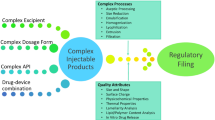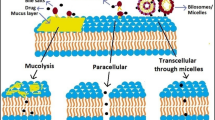Abstract
The present work was aimed at formulating a SMEDDS (self-microemulsifying drug delivery system) of fenofibrate and evaluating its in vitro and in vivo potential. The solubility of fenofibrate was determined in various vehicles. Pseudoternary phase diagrams were used to evaluate the microemulsification existence area, and the release rate of fenofibrate was investigated using an in vitro dissolution test. SMEDDS formulations were tested for microemulsifying properties, and the resultant microemulsions were evaluated for clarity, precipitation, and particle size distribution. Formulation development and screening was done based on results obtained from phase diagrams and characteristics of resultant microemulsions. The optimized formulation for in vitro dissolution and pharmacodynamic studies was composed of Labrafac CM10 (31.5%), Tween 80 (47.3%), and polyethylene glycol 400 (12.7%). The SMEDDS formulation showed complete release in 15 minutes as compared with the plain drug, which showed a limited dissolution rate. Comparative pharmacodynamic evaluation was investigated in terms of lipid-lowering efficacy, using a Triton-induced hypercholesterolemia model in rats. The SMEDDS formulation significantly reduced serum lipid levels in phases I and II of the Triton test, as compared with plain fenofibrate. The optimized formulation was then subjected to stability studies as per International Conference on Harmonization (ICH) guidelines and was found to be stable over 12 months. Thus, the study confirmed that the SMEDDS formulation can be used as a possible alternative to traditional oral formulations of fenofibrate to improve its bioavailability.
Similar content being viewed by others
References
Pouton CW. Lipid formulations for oral administration of drugs: non-emulsifying, self-emulsifying and ‘self-microemulsifying’ drug delivery systems. Eur J Pharm Sci. 2000; 11: S93-S98.
Constantinides PP. Lipid microemulsions for improving drug dissolution and oral absorption: physical and biopharmaceutical aspects. Pharm Res. 1995; 12: 1561–1572.
Kim HJ, Yoon KA, Hahn M, Park ES, Chi SC. Preparation and in vitro evaluation of self-microemulsifying drug delivery systems containing idebenone. Drug Dev Ind Pharm. 2000; 26: 523–529.
Kang BK, Lee JS, Chona SK, et al. Development of self-microemulsifying drug delivery systems (SMEDDS) for oral bioavailability enhancement of simvastatin in beagle dogs. Int J Pharm. 2004; 274: 65–73.
Shah NH, Carvajal MT, Patel CI, Infeld MH, Malick AW. Self-emulsifying drug delivery systems (SEDDS) with polyglycolysed glycerides for improving in vitro dissolution and oral absorption of lipophilic drugs. Int J Pharm. 1994; 106: 15–23.
Charman SA, Charman WN, Rogge MC, Wilson TD, Dutko FJ, Pouton CW. Self-emulsifying drug delivery systems: formulation and biopharmaceutic evaluation of an investigational lipophilic compound. Pharm Res. 1992; 9: 87–93.
Kommuru TR, Gurley B, Khan MA, Reddy IK. Self-emulsifying drug delivery systems (SEDDS) of coenzyme Q10: formulation development and bioavailability assessment. Int J Pharm. 2001; 212: 233–246.
Physician’s Desk Reference 2000. 54th ed. Montvale, NJ: Medical Economics Company; 2000: 476–477.
Kasim NA, Whitehouse M, Ramachandran C, et al. Molecular properties of WHO essential drugs and provisional biopharmaceutical classification. Mol Pharm. 2004; 1: 85–96.
Patel AR, Vavia PR. Effect of hydrophilic polymer on solubilization of fenofibrate by cyclodextrin complexation. J Incl Phenom Macrocycl Chem. 2006; 56: 247–251.
Law D, Wang W, Schmitt E, Qiu Y, Krill SK, Fort JJ. Properties of rapidly dissolving eutectic mixtures of poly(ethylene glycol) and fenofibrate: the eutectic microstructure. J Pharm Sci. 2003; 92: 505–515.
Curtet B, Teillaud E, Reginault P, inventors. Fournier Innovation et Synergie, assignee. Novel dosage form of fenofibrate. US patent 4 895 726. January 23, 1980.
Tricor. fenofibrate [package insert]. North Chicago, IL: Abbott Laboratories. 2002.
Khoo SM, Humberstone AJ, Porter CJ, Edwards GA, Charman WN. Formulation design and bioavailability assessment of lipidic self-emulsifying formulations of halofantrine. Int J Pharm. 1998; 167: 155–164.
Zlatkis A, Zak B, Boyle AJ. New method for direct determination of serum cholesterol. J Lab Clin Med. 1953; 41: 486–492.
Foster IB, Dunn RT. Stable reagents for determination of serum triglycerides by a colorimetric Hantzsch condensation method. Clin Chem. 1973; 19: 338–340.
Groves MJ. The self-emulsifying action of mixed surfactants in oil. Acta Pharm Suec. 1976; 13: 361–372.
Schulman JH, Montagne JB. Formation of microemulsions by amino alkyl alcohols. Ann N Y Acad Sci. 1961; 92: 366–371.
Mei X, Etzler FM, Wang Z. Use of texture analysis to study hydrophilic solvent effects on the mechanical properties of hard gelatin capsules. Int J Pharm. 2006; 324: 128–135.
Gao ZG, Choi HG, Shin HJ, et al. Physicochemical characterization and evaluation of a microemulsion system for oral delivery of cyclosporin A. Int J Pharm. 1998; 161: 75–86.
Constantinides PP, Scalart JP. Formulation and physical characterization of water-in-oil microemulsions containing long-versus medium-chain glycerides. Int J Pharm. 1997; 158: 57–68.
de Campo L, Yaghmur A, Garti N, Leser ME, Folmer B, Glatter O. Five-component food-grade microemulsions: structural characterization by SANS. J Colloid Interface Sci. 2004; 274: 251–267.
Szekeres E, Acosta E, Sabatini DA, Harwell JH. A two-state model for selective solubilization of benzene-limonene mixtures in sodium dihexyl sulfosuccinate microemulsions. Langmuir. 2004; 20: 6560–6569.
Nutting DF, Tso P. Hypolipidemic effects of intravenous pluronic L-81 in fasted rats treated with Triton WR-1339; possible inhibition of hepatic lipoprotein secretion. Horm Metab Res. 1989; 21: 113–115.
Schurr PE, Schultz JR, Parkinson TM. Triton-induced hyperlipidemia in rats as an animal model for screening hypolipidemic drugs. Lipids. 1972; 7: 68–74.
Krishnamurthy A, Thapar GS. Effect of benzafibrate and nicotinic acid on Triton-induced hyperlipidemias in CFY rats. Indian J Med Res. 1991; 94: 395–398.
Mahley RW, Bersot TP. Drug therapy for hypercholesterolemia and dyslipidemia. In: Brunton LL, Lazo JS, Parker KL, eds. Goodman & Gilman’s The Pharmacological Basis of Therapeutics. 11th ed. New York, NY: McGraw Hill; 2006: 957–958.
Author information
Authors and Affiliations
Corresponding author
Additional information
Published: October 26, 2007
Rights and permissions
About this article
Cite this article
Patel, A.R., Vavia, P.R. Preparation and in vivo evaluation of SMEDDS (self-microemulsifying drug delivery system) containing fenofibrate. AAPS J 9, 41 (2007). https://doi.org/10.1208/aapsj0903041
Received:
Revised:
Accepted:
DOI: https://doi.org/10.1208/aapsj0903041




